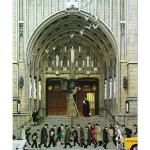When the seventh trumpet sounds, the heavenly temple of God is opened and the ark appears. Lightning, thunder, an earthquake, and a great hailstorm accompany the revelation of the Lord’s throne (11:19). This verse opens a section of several chapters that deal with the Satanic attack on the church, persecution by the beasts, and finally the outpouring of martyr blood on the city. It’s a transitional vision, and illuminates much of what happens in the following chapters.
First, we can note what precedes the opening of the heavenly temple. This is after the seventh trumpet sounds, after the events of the trumpet sequence, and especially after the climactic sixth trumpet and the death and vindication of the two witnesses. Only after all that has happened does the heavenly sanctuary open; only then is the firmament veil broken and the ark revealed.
When Jesus died, the veil of the temple was torn from top to bottom (Matthew 27:51; Mark 15:38; Luke 23:45). With the final sacrifice, the way was open; the exclusions inherent in the temple system were annulled. In Revelation, the sanctuary is not opened until we have the first martyrs, the two witnesses, who are killed for their testimony to Jesus. When they die, another veil is torn, another sanctuary opened.
John does not record this incident that is found in all the synoptics. And what he does record in Revelation is the opening of the heavenly temple, not the opening of the earthly sanctuary. The heavenly sanctuary is opened, and it is opened not by the death of Jesus but by the death of two witnesses to Jesus. Jesus opens the earthly sanctuary, but only when the saints begin to mingle their blood with his does the heavenly sanctuary open.
Second, as soon as the temple in heaven (?? ?? ??????) is open, there are great signs in heaven (?? ?? ??????, 12:1, 3). The heavenly sanctuary opens to reveal an ark and also to reveal a woman and a dragon. The initial drama of the woman and the dragon is taking place in heaven, either in the heavenly sanctuary or at least before the ark-throne.
Against the background of the Old Testament depictions of Satan, this is not surprising. When the sons of God assemble before Him in Job 1-2, Satan is among them. Satan is beside the high priest in Zechariah 3. The accuser of the brethren is on the heavenly sanctuary, accusing and slandering the saints before the enthroned Lord. Over the course of the story in Revelation 12, the dragon is cast from heaven, the accuser of the brothers thrown down (v. 10). The heavenly sanctuary is opened first of all so that Satan can be kicked out and thrown down to earth.
Finally, the fact that the ark is visible in the heavenly temple means that we are starting the day of atonement, the one day when the inner sanctuary was opened and the ark was visible. The next few chapters are a dramatic day of atonement. That becomes especially clear in chapters 15-16, where angels come out of the heavenly sanctuary and pour out seven bowls of blood onto the city, causing the harlot city to fall. But the whole sequence is part of a day of atonement, the final atonement. Again, in John’s theology this final day of atonement involves not only the blood of Jesus but the blood of those who testify to Jesus.
This fits with the overall sequence of Revelation, which follows the seven feasts of Leviticus 23. We are in the “seventh month” of the liturgical calendar of Revelation. Chapter 11 gives us the seventh trumpet, which matches the feast of trumpets that began the seventh month of Israel’s calendar. Within that seventh trumpet, we begin the day of atonement section, which lasts through chapter 16.














